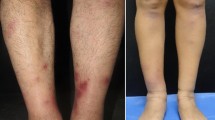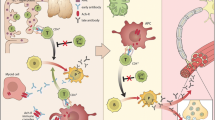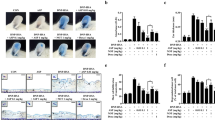Abstract
The systemic anaphylactic reaction and thein vitro anaphylactic contraction of the terminal segment of the ileum performed according to the Schultz-Dale technique, were elicited in guinea pigs passively sensitized with rabbit antibodies to human serum albumin, using whole and cathepsin D degraded antigen. The intensity of the systemic anaphylactic response that was evoked by degraded antigen was lower; a highly significant suppression of the response was obtained provided an antigen degraded more than by 70% was injected. With an increasing degradation of antigen, more animals responded with lower or even with no reaction; the number of animals developing severe or lethal shock, decreased at the same time. The number of animals that developed a medium anaphylactic response remained at the same level. The degraded antigen did not evoke the anaphylactic contraction of the terminal segment of the ileumin vitro, and moreover, it blocked the contraction after addition of the whole antigen.
Similar content being viewed by others
References
Amemiya H., Yokoyama T., Torisu M., Putnam C. W., Anderson J. T., Starzl T. E.: The reduction of antigenicity of heterologous antilymphocyte serum with acid Taka-protease.Clin. Exptl. Immunol.11, 67 (1972).
Amkraut A. A., Rosenberg L. T., Raffel S.: Elicitation of PCA by univalent and divalent haptens.J. Immunol.91, 644 (1963).
Barrett A. J., Dingle J. T. (Eds.):Tissue Proteinases. North-Holland Publishing Company, Amsterdam-London, American Elsevier Publishing Co., Inc.—New York 1971.
Borek T. (Ed.):Immunogenicity. North-Holland Publishing Company, Amsterdam-London 1972.
Campbell D. H., Garvey J. S.: Nature of retained antigen and its role in immune mechanisms.Adv. Immunol.3, 261 (1963).
Campbell D. H., Garvey J. S.: Localization and fate of foreign antigens in tissues, p. 18, in M. Samter, H. L. Alexander (Eds.):Immunological Diseases, Little, Brown and Comp., Boston 1965.
Das B. R., Maurer P. H., Liu C. T.: Some immunological studies with heat-denaturated bovine serum albumin and its peptic, tryptic and chymotryptic peptides.Proc. Soc. Exptl. Med.133, 1456 (1970).
Green J. F., Thielke K. G., Raffel S.: Univalent antigen as elicitor of anaphylactic reactions.J. Immunol.104, 863 (1970).
Haurowitz F.:Immunochemistry and the Biosynthesis of Antibodies. Interscience Publishers, New York-London-Sydney 1968.
Heidelberger M., Kendall F. E.: A quantitative study of the precipitin reaction between type IIIPneumococcus polysacharide and purified homologous antibody.J. Exptl. Med.50, 809 (1929).
Hoene R., Swineford O., Quelch S.: Desensitization with haptens.J. Allergy32, 381 (1961).
Ichiki A., Parish C. R.: Clevage of bacterial flagellin with proteolytic enzymes. I. Physicochemical and antigenic properties of the tryptic and peptic peptides.Immunochemistry9, 153 (1972).
Kabat E. A., Mayer M. M.:Experimental Immunochemistry. Charles C. Thomas, Publisher Springfield, Illinois 1961.
Kaminski M.: The analysis of the antigenic structure of protein molecules.Progr. Allergy9, 79 (1965).
Lapresle C.: Étude de la dégradation de la sérumalbumine humaine par un extrait de rate de lapin. II. Mise en évidence de trois groupements spécifiques différents dans le motif antigénique de l’albumine humaine et de trois anticorps correspondants dans le sérum de lapin anti albumine humaine.Ann. Inst. Pasteur89, 654 (1955).
Lapresle C.: Hétérogénéité des anticorps anti-protéines.Ann. Inst. Pasteur97, 626 (1959).
Lapresle C.: Rabbit cathepsins D and E p. 135, in A. J. Barrett, J. T. Dingle (Eds.):Tissue Proteinases, North-Holland Publishing Company, Amsterdam-London, American Elsevier Publishing Co., Inc.— New York, 1971.
Lapresle C., Goldstein I. J.: Immunogenicity of a fragment of human serum albumin.J. Immunol.102, 733 (1969).
Lapresle C., Webb T.: Degradation of a protein antigen by intracellular enzymes, p. 44, inCiba Foundation Symposium on Cellular Aspects of Immunity 1960a.
Lapresle C., Webb T.: Étude de la dégradation de la sérumalbumine humaine par un extrait de rate de lapin. VII. Isolement et propriétés d’un fragment d’albumine.Ann. Inst. Pasteur99, 523 (1960b).
Lapresle C., Webb T.: The purification and properties of a proteolytic enzyme, rabbit cathepsin E and further studies on rabbit cathepsin D.Biochem. J.84, 455 (1962).
Lapresle C., Kaminski M., Tanner C. E.: Immunochemical study of the enzymatic degradation of human serum albumin: an analysis of the antigenic structure of a protein molecule.J. Immunol.82, 94 (1959).
Liu C. T., Das B. R., Maurer P. H.: Immunochemical studies of the tryptic, chymotryptic and-peptic peptides of the heat denaturated bovine serum albumin.Immunochemistry4, 1 (1967).
McDuffie F. C., Kabat E. A.: A comparative study of methods used for analysis of specific precipitat in quantitative immunochemistry.J. Immunol.77, 193 (1956).
Mitchison N. A.: Dose, frequency and route of administration of antigen, p. 87, in F. Borek (Ed.):Immunogenicity, North-Holland Publishing Company, Amsterdam-London 1972.
Rhodes J.:In vitro studies on the fate of antigen.Acta Pathol. Microbiol. Scand. Section B79, 153 (1971).
Richter W.: Hapten inhibition of passive antidextran dextran anaphylaxis in guinea pigs.Int. Arch. Allergy Appl. Immunol.41, 826 (1971).
Ryan W. L., Lee J. W.: Antigen catabolism by lysosomal enzymes.Immunochemistry7, 251 (1970).
Schwartz R. S., Ryder R. J. W., Gottlieb A. A.: Macrophages and antibody synthesis.Progr. Allergy Appl. Immunol.11, 81 (1970).
Sónak R., Štefanovič J.: The passive anaphylactic reaction in guinea pigs. (In Slovak)Bratisl. Lek. Listy37, 606 (1957).
Štefanovič J.: Proteases of rabbit polymorphonuclear leukocytes, macrophages and lymphocytes and their relation to the degradation of antigen. (In Slovak)Folia Fac. Med. Univ. Comenianae2, 3 (1964).
Štefanovič J., Bergendi L’.: Intensity of anaphylactic reaction after the degradation of antigen by the cell proteases, p. 116, inSymposium Allergologicum Pragae, Praha 1967.
Štefanovič J., Ferenčík M.: The inhibitory effect of homologous immunoglobulin G on the degradation of antigen (human serum albumin) by rabbit cathepsin D.Folia Microbiol.14, 571 (1969).
Štefanovič J., Kotulová D.: The influence of the rabbit’s white blood picture and trypsin inhibitor levels of injections of integral and cathepsin D degraded antigen. (In Slovak)Bratisl. Lek. Listy46, 330 (1966).
Štefanovič J., Webb T., Lapresle C.: Étude des cathepsins D et E dans de préparations de polynucléaires, de macrophages et de lymphocytes de lapin.Ann. Inst. Pasteur103, 276 (1962).
Weck A. L. de, Schneider C. H.: Some observations on the molecular mechanisms of immediate type allergic reactions.Int. Arch. Allergy Appl. Immunol.36, 62 (1969).
Whitehouse F., Mayhew H. E.: The enzymatic digestion of rabbit anti-Ehrlich ascites tumor cell globulin.The University of Michigan Med. Bull.25, 403 (1959).
Yuan L., Campbell D. H.: A unique low molecular weight antigen fragment associated with oligoribonucleopeptide in lymph nodes and spleen.Immunochemistry8, 185 (1971).
Yuan L., Campbell D. H.: Thein vivo andin vitro immunogenicity and antigenic specificity of lymphoid antigen fragment-oligoribonucleopeptide conjugates.Immunochemistry9, 1 (1972).
Yuan L., Garvey J. S., Campbell D. H.: Molecular forms of antigen in the circulation following immunization.Immunochemistry7, 601 (1970).
Author information
Authors and Affiliations
Rights and permissions
About this article
Cite this article
Štefanovič, J., Kotulová, D., Bergendi, L. et al. The passive anaphylactic reaction in guinea pigs elicited by whole and cathepsin D-degraded antigen. Folia Microbiol 19, 71–78 (1974). https://doi.org/10.1007/BF02874506
Received:
Issue Date:
DOI: https://doi.org/10.1007/BF02874506




